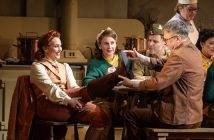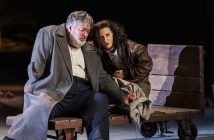By happy coincidence the last operatic production I reviewed was Rossini’s Barber of Seville, the prequel, in terms of the story if not the composition, to Mozart’s The Marriage of Figaro. And while I remember coming away from that evening impressed by the comic timing and light touch of the director and cast, Fiona Shaw’s new production of Mozart’s classic is, to say the least, a much meatier affair.
This is the third time Shaw – the Irish actress most famous for her roles in the Harry Potter films and the HBO series True Blood – has directed for the ENO. Her first two productions were, by and large, greeted with approval by critic and audience alike, but this is the first time she has taken the helm for one of opera’s real crowd pleasers, and with interesting results.
The programme reminds us that the The Marriage of Figaro is an opera buffa in four acts, but this was probably the least buffoonish Figaro I have seen (not necessarily a criticism). The set has been designed to exaggerate the confusion and disharmony that is at the heart of the plot and consists of a revolving, maze-like (and occasionally gloomy) structure, populated by servants clad in black and decorated with man traps and the type of horns you’d usually see as a trophy on a Texan SUV. These horns act as a recurring motif throughout the performance: the programme mentions the Count as the Minotaur in his labyrinth, but I preferred to think of them as an explicit reference to the plot revolving around the male characters’ burgeoning libidos.
Indeed it is the male characters which are at the heart of the first half of the opera. Roland Wood’s alpha male of a Count rules his court with an iron rod and servants either scatter before him or proclaim their gratefulness at his abolition of the droit de seigneur. At various points his simmering rage threatened to boil over into bloody murder, via scythe, sword or bare hands. Iain Paterson’s Figaro cuts scarcely less a dominating figure; the scene in which he packs the pubescent Cherubino off to the army with the famous aria ‘Non Piu Andrai’ was a more brutal exercise than I remember from previous productions.
This is not to say that the female characters are there only as an afterthought, but it is not until after the interval, in the third and fourth acts, that the odds even up and we see the predictable triumph of feminine wit and guile over masculine brute force. There is a subtle change of emphasis, as the set opens out somewhat. Instead of threatening violence on those who get in his way, we find the Count, in a scene lifted straight from Monty Python, impotently beating a table with a bunch of flowers.
This descent finds its nadir in the final garden scene, when the Count and Figaro are tricked and made fools of by their respective spouses. The Count experiences the final indignity of wandering the garden, confused, in his pants and a pair of wellington boots, whilst Figaro is left bemoaning his fate at the hands of the fairer sex.
Despite the ending, this, in many ways, felt like a very masculine Figaro. But in terms of the performances, it was the female leads, and most notably Elizabeth Llewellyn as the Countess, who stole the show. Llewellyn, who stepped in at the last minute after Kate Valentine had been forced through illness to pull out that morning, proved far more than just a competent replacement; her rich soprano and excellent acting managed to portray both the vulnerability of the Countess in mourning for her marriage and the strength of a woman willing to stand up to, and make a fool of, her bully of a husband.
She was very ably supported by the American soprano Devon Guthrie in the role of Susanna, Figaro’s bride to be and the object of the Count’s affections, and Kathryn Rudge, who did well as Cherubino, the youthful adonis/boy wonder/awkward teenager. An honourable mention should also go to Timothy Robinson as the blind music master and Count’s romantic fixer Don Basilio, who sang in a sweet tenor and featured in an amusing set piece involving a harpsichord and a bumblebee!
Mozart’s score needs very little in the way of endorsements, but as usual the famous overture served to stiffen the sinews in preparation for the battle ahead. It is a little known fact that such was Mozart’s musical genius, the overture serves a dual purpose: if you put an egg on to boil at the conductor’s first wave of the baton, by the time the last note has died away, your egg will be perfectly boiled with a runny yolk – hence its very occasional nickname ‘the egg-timer’.
The only caveat I would add regarding the music is that I sometimes felt that the overall pace of the opera dropped slightly and, while this was not solely down the musicians, the conductor Paul Daniel could have done more to chivvy the orchestra along and add a bit more urgency.
By the time of the final curtain call (at least the fourth or fifth by my count), I was left with a few questions to ponder as to the overall success of Shaw’s production. Did the gloomy and complicated set jar too much with the light and airy score? Did this Figaro, which highlighted the disharmony of the relationships at its centre, lose too much of the farce and comic moments, which are at the heart of a more conventional production?
Overall I did feel that some of the charm went out of the production with the emphasis on the more serious aspects of the story. The alternative name for The Marriage of Figaro is The Day of Madness, and while there certainly was madness, it was more The Shining than Dumb and Dumber. However, there is much to enjoy here and Fiona Shaw’s production certainly deserves a viewing.
The Marriage of Figaro runs until 10 November 2011 at the London Coliseum, St. Martin’s Lane, London WC2N 4ES. Tel : +44 (0) 871 911 0200. Website.




